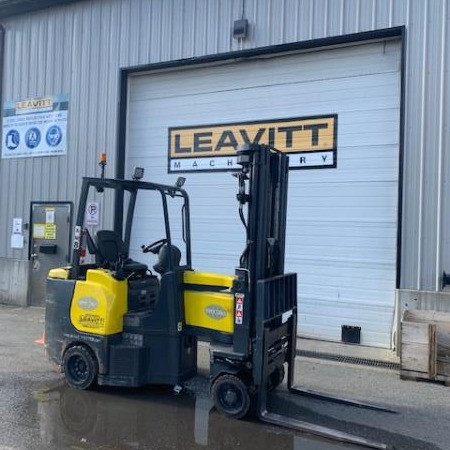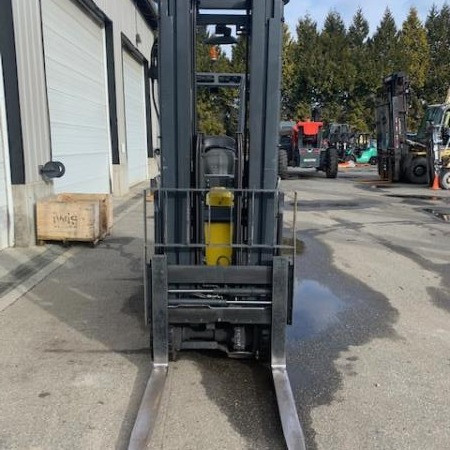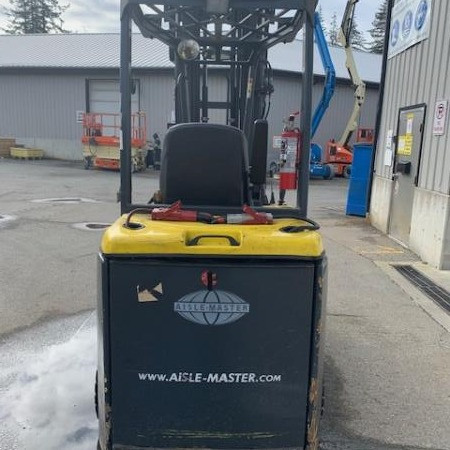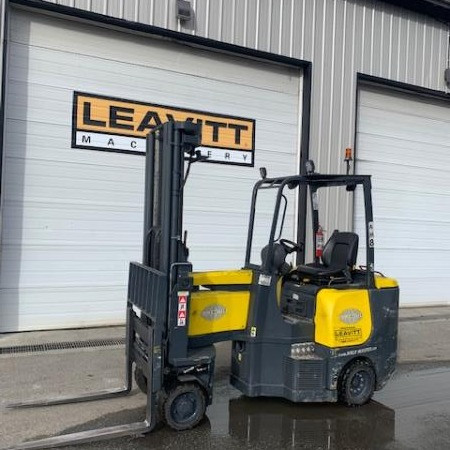Very Narrow Aisle Forklift Portland
Used Very Narrow Aisle Forklift Portland - Getting items from one warehouse location to another and to and from the loading docks is the focus of warehousing. Focus is often on space saving tools and the layout of the building. Narrow aisles need specific solutions to allow goods to be accessed and stored properly. More space can be given to storage as less space is needed for accessing the aisle. These warehouse configurations are often referred to as warehouse optimization.
Warehouse Optimization
There are several significant benefits of implementing very narrow aisle warehouse optimization.
Using narrow forklift trucks instead of traditional forklifts can enable the warehouse width of the aisles can be lessened to half. Numerous narrow aisle forklifts deliver better stacking heights to increase the storage capacity on a square foot basis. Costs can be drastically decreased with a narrow aisle forklift compared to a standard aisle configuration as less warehouse space is required for the same quantity of stock. Square footage is costly in urban areas and any way to reduce warehousing costs can save a company money. Adding a very narrow aisle width system can increase storage up to eighty percent when planned properly. Very narrow aisle design facilitates greater product access and more rack faces. This usually equates to less travel time gathering and storing product as more product is located within a smaller, more accessible area.
It is common for warehouses to use a very narrow or narrow aisle layout. Less than eleven feet of aisle width is needed by narrow aisles. Very narrow aisles reduce the aisle width further to around six-and-a-half feet. Either of these widths drastically increases storage potential. Standard forklifts can have issues with turning in these aisle widths. To meet these challenges, several different types of very narrow forklifts have been specially developed for various types of tasks to allow easier maneuvering in narrow aisle widths.
Before choosing a forklift for a particular job, it is vital to know the dimensions of the aisle. Having the right aisle dimensions will save money and time instead of purchasing the wrong forklift that won’t be able to conquer the applications. It is essential to take any columns, posts or utilities into account before deciding a type of narrow aisle forklift design as these can block access.
Very Narrow Aisle Forklift Trucks
Very narrow aisle forklift trucks are almost always powered electrically, usually by rechargeable battery. These very narrow aisle trucks are more commonly available as stand-up riders, which helps increase productivity and operator comfort. The most commonly used types of very narrow aisle forklift trucks are:
1. Reach trucks
2. Order pickers;
3. End-control riders; and
4. Turret or swing-mast.
Reach Forklift Trucks
Developed as a kind of rider stacker forklift, the reach forklift trucks can be configured for narrow aisle locations. It got its name by its function of reaching its forks forward to get to a load. There are two types of reach trucks: the moving mast and the moving carriage. The moving carriage functions by lowering and raising the carriage and the operator. The moving mast raises and lowers the forks as the operator remains at ground level. The moving mast reach truck is generally considered the safer of the two types of reach trucks. These machines rely on a kind of jointed framework known as a pantograph system that enables the operator to place a load or reach the load without moving the machine.
Order Pickers
Order pickers have been created to pick items from difficult, high racking systems. Order pickers are specific for lighter stock items that can be lifted by hand. Order pickers elevate the operator to the level of goods to pick and identify particular items required for filling an order.
End-Control Riders
End-control riders are used to pick loads located at floor level and transport the load horizontally, rather than lift or lower loads from various heights.
Turret or Swing-Mast Forklift
The turret or swing mast very narrow aisle forklifts have a swivel mast that pivots and articulates. Pallets can be set on either the right or left side of the forklift due to the machine’s ability to use its’ swinging mast.
Guided Very Narrow Aisle Trucks
Many very narrow aisle forklift trucks are able to be guided down aisles by wire or rail.
Because the forklift is guided, thereby reducing the possibility of the forklift bumping racks while moving down the aisle, the aisles can be extremely narrow. For rail-guided systems, a series of rails are installed into the floor, on both sides of the aisle, and run along the floor for the length of the aisle, curving around the end of the aisle. Specific wheel guides are on the forklift. These slide into the rails to stop the forklift from moving out of the rail guards.
Wire-guidance forklift systems install wires on the floor instead of rails and the wires run down the middle of the aisle. The wire-guides function similarly to the rail systems except the forklift has a wire-guide system to prevent the machine from traveling where it is not supposed to.
Work Site Considerations
There are a few critical considerations when implementing a very narrow aisle configuration. The narrow aisle units feature tall racking systems. The floor construction and the racks need to be carefully taken into account for everyone’s safety. There are four areas which must be meticulously prepared before setting up a racking system and must be continuously monitored and maintained throughout the operation of the warehousing system:
1. The floor must be level;
2. Cracks must be repaired;
3. Load capacity of floor must be appropriate; and
4. The racks must be plumb.
Level Floor
Because of the height of the racking systems, any slight slope of the floor is likely to negatively affect the plumbness of the racks, especially over time when loads are continuously placed and removed on the racks. Without a level floor foundation, the rack stability could be compromised.
Crack Repair
When cracks in the floor are spotted, they should be assessed and, when necessary, repaired immediately. The level of the floor can become unstable with cracks when they are only 3/8 inches wide. They will need to be filled properly with material as hard as the rest of the floor.
Floor Load Capacity
The floor needs to meet specific minimum requirements prior to a narrow aisle configuration. At a minimum, the floor should consist of 3,000 psi concrete as well as contain evenly distributed rebar approximately 3 to 4 inches below the surface. Extra reinforcements might be needed depending on the load requirements and the configuration.
Plumb Racks
The racking system is essential to the whole process and needs to be installed properly. Rack failure can happen if they are improperly installed. All racks need to be plumb and this is one of the most vital aspects of correct installation. If necessary, rack shims should be used to ensure the racks are plumb within 1 inch at the 30 foot height of the racks.
If the above measures are not taken or are improperly implemented, it is likely to cause a racking failure. Employees can become hurt or killed in the event that racking failure occurs. Goods can be damaged along with forklifts and other equipment. These measurements are vital to the success of installing a safe and productive narrow aisle configuration.
Very Narrow Aisle Forklift PDF
Stock Number: 207213 GL
Make: AISLEMASTER
Model: 44E
Year: 2013
| Stock Number |
207213 GL |
| Make |
AISLEMASTER |
| Model |
44E |
| Year |
2013 |
| Category |
Very Narrow Aisle Forklift |
Stock Number: 209213 GL
Make: AISLEMASTER
Model: 44SE
Year: 2015
| Stock Number |
209213 GL |
| Make |
AISLEMASTER |
| Model |
44SE |
| Year |
2015 |
| Category |
Very Narrow Aisle Forklift |
Stock Number: 208758 GL
Make: AISLEMASTER
Model: 44SE
Year: 2015
| Stock Number |
208758 GL |
| Make |
AISLEMASTER |
| Model |
44SE |
| Year |
2015 |
| Category |
Very Narrow Aisle Forklift |













